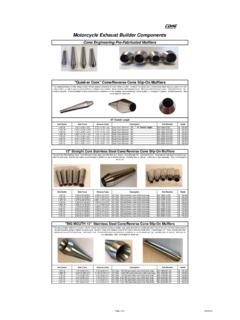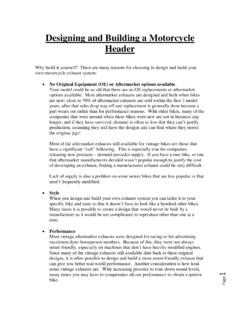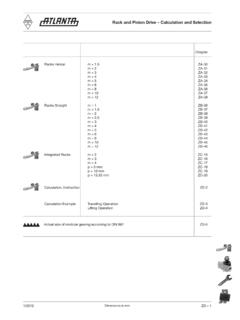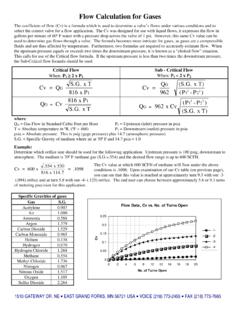Transcription of AREA GROWTH OF PRIMARY TUBE TO OUTLET TUBE
1 PRIMARY Collector OUTLET Diameter (collector "choke", before megaphone or transition cone added)Tube Diam " 1501% 1926% 2401% 1500% 1875% 1500% chart represents the area GROWTH from the collector PRIMARY tube relative to the collector OUTLET , or "choke point" of the merge collector. This is the point before any megaphone or transition cone is added to the - you never have all cylinders firing at once, so the area GROWTH is one PRIMARY tube relative to the collector a general rule of thumb, the farther apart the pulses/firing order, the tighter you want to keep the area of your exhaust gas like water flow, if you increase the volume of the container too quickly, you lose relative velocity.
2 But keep the containertight, and velocity stays up. Velocity is key to good exhaust sound and to superior normally aspirated 4-1 headers (including nitrous) an increase of 100% to 150% works very well. For an extremely large HP motor, up to 200% can still be effectiveas these motors are generally used for drag racing where torque is often sacrificed for max HP. Forced induction motors are able to run larger diameters as they are not critically concerned with scavenging but you still want a reasonable diameter that maximizes velocity for most efficient evacuation. If you go to too large of a diameter, the motor is forced to expend energy (HP) pushing the exhaust gas out of the 3-1 headers, best results tend to come with an increase of 100% or slightly 2-1 collectors used on motorcycles you will normally want an increase of around 50-75% to maintain maximum velocity of the exhaust gas pulse.
3 Older/slower-revving motors tend to work better with increases on the smaller side of the range while newer/faster revving engines can go for increases on the larger side of the 2-1 collectors used to join dual car headers into a single exhaust, an increase of 30% to around 50% seems to work very 2-1 collectors used for Tri-Y style headers you will usually want a much smaller increase, normally around 15-30% per tube consider what your vehicle is being used for. Drag racing tends to allow for larger than average collector diameters as you are usually able to sacrifice torque for max HP. Though a heavy car on an 1/8 mile want to consider that more carefully. Likewise, road racing or street use tends to benefit from a tighter collector OUTLET to gain torque over max GROWTH OF PRIMARY TUBE TO OUTLET TUBE


















